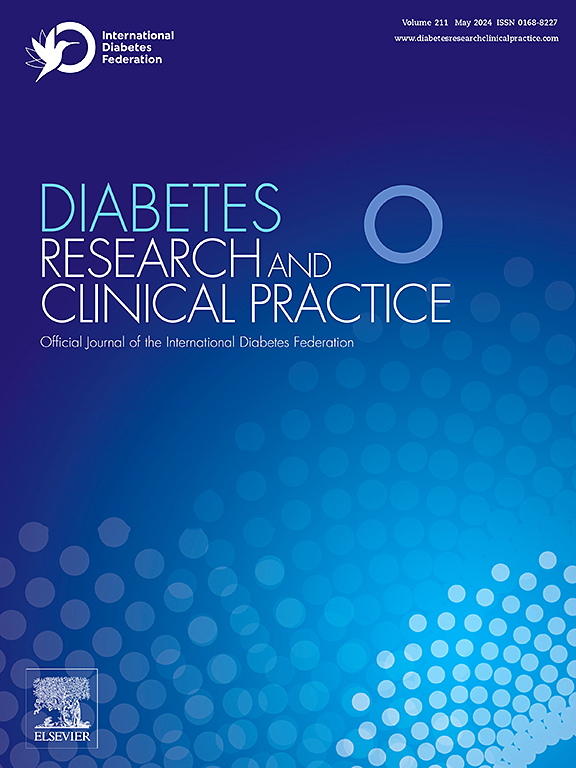皮下塞马鲁肽治疗2型糖尿病的药物依从性、血糖控制和体重减轻。
IF 6.1
3区 医学
Q1 ENDOCRINOLOGY & METABOLISM
引用次数: 0
摘要
研究背景:我们描述了一个大型现实世界2型糖尿病(T2D)患者队列中HbA1c和体重的变化以及药物依从性与临床反应之间的关系,该队列接受了长达三年的皮下塞马鲁肽治疗。方法:我们纳入了在以色列马卡比医疗服务中心登记的T2D成人患者,他们开始使用西马鲁肽(2019年8月至2022年6月)。依从性以覆盖天数比例(PDC)评估,基于药物分配。我们评估了HbA1c从基线的绝对变化和体重的相对变化。结果:23,442名参与者(11,513名女性)的平均年龄为62.2 岁,HbA1c为7.6 %,BMI为33.7 kg/m2。与基线相比,在6 个月、2 年和3 年时,HbA1c的平均降低分别为0.77[95 %CI 0.75-0.78]、0.57[0.53-0.61]和0.35[0.27-0.44]个百分点。体重减少分别为4.9 %[4.8-5.0]、5.3 %[5.1-5.5]和4.7 %[4.1-5.2]。在6049例 ≥2年潜在随访的患者中,0-6 个月的中位PDC为83.9 %,此后保持相对稳定,18-24 个月达到74.6 %。较高的PDC与更明显的HbA1c和体重降低相关。结论:西马鲁肽在现实世界的长期依从性相对稳定。Semaglutide的使用与T2D患者持续的血糖和体重下降以及相对良好的基线血糖控制相关,特别是在那些高依从性的患者中,支持其用于T2D的长期管理。本文章由计算机程序翻译,如有差异,请以英文原文为准。
Drug adherence, glycemic control, and weight reduction with subcutaneous semaglutide in real-world management of type 2 diabetes
Background
We describe changes in HbA1c and body-weight and the relationship between drug adherence and clinical response in a large real-world cohort of patients with type 2 diabetes (T2D) treated with subcutaneous semaglutide for up to three years.
Methods
We included adults with T2D registered at Maccabi Healthcare Services, Israel, who initiated subcutaneous semaglutide (August 2019 – June 2022). Adherence, assessed as Proportion of Days Covered (PDC), was based on drug’s dispensation. We assessed the absolute change in HbA1c and the relative change in body-weight from baseline.
Results
The 23,442 participants (11,513 women) had a mean age of 62.2 years, HbA1c of 7.6 %, and BMI of 33.7 kg/m2. Compared to baseline, the mean reductions in HbA1c were 0.77 [95 %CI 0.75–0.78], 0.57 [0.53–0.61], and 0.35 [0.27–0.44] %-points at 6 months, 2 years, and 3 years, respectively. The respective body-weight reductions were 4.9 % [4.8–5.0], 5.3% [5.1–5.5], and 4.5 % [3.7–5.2]. Among 6049 patients with ≥2 years of potential follow-up, median PDC between 0–6 months was 83.9 %, and remained relatively stable thereafter, reaching 74.6 % between 18–24 months. Higher PDC was associated with more pronounced HbA1c and body-weight reductions.
Conclusions
Long-term real-world adherence with semaglutide was relatively stable. Semaglutide use was associated with sustained glycemic control and weight reduction in patients with T2D and relatively good baseline glycemic control, especially among those with high adherence, supporting its use for long-term management of T2D.
求助全文
通过发布文献求助,成功后即可免费获取论文全文。
去求助
来源期刊

Diabetes research and clinical practice
医学-内分泌学与代谢
CiteScore
10.30
自引率
3.90%
发文量
862
审稿时长
32 days
期刊介绍:
Diabetes Research and Clinical Practice is an international journal for health-care providers and clinically oriented researchers that publishes high-quality original research articles and expert reviews in diabetes and related areas. The role of the journal is to provide a venue for dissemination of knowledge and discussion of topics related to diabetes clinical research and patient care. Topics of focus include translational science, genetics, immunology, nutrition, psychosocial research, epidemiology, prevention, socio-economic research, complications, new treatments, technologies and therapy.
 求助内容:
求助内容: 应助结果提醒方式:
应助结果提醒方式:


